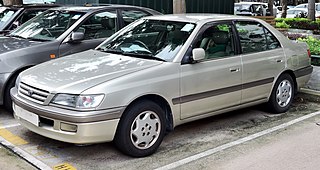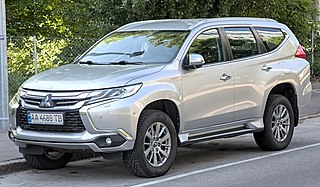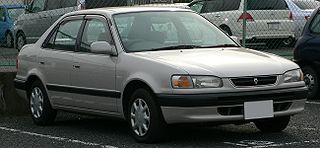
The Toyota Avensis is a mid-size/large family car built in Derbyshire, United Kingdom by the Japanese automaker Toyota from October 1997 to August 2018. It was the direct successor to the European Carina E and was available as a four-door saloon, five-door liftback and estate.

The Toyota Starlet is a subcompact car manufactured by Toyota from 1973 until 1999, replacing the Publica, but retaining the Publica's "P" code and generation numbering. The first generation Starlet was sold as the Publica Starlet in some markets. In Japan, it was exclusive to Toyota Corolla Store dealers.

The Mazda Bongo, also known as Mazda E-Series and the Ford Econovan, is a cabover van and pickup truck manufactured by the Japanese automobile manufacturer Mazda since 1966. The Bongo name was also used for the Bongo Friendee, which is not a cabover design.

The Toyota Corona is an automobile manufactured by the Japanese automaker Toyota across eleven generations between 1957 and 2001. On launch, the Corona was Toyota's second-highest product in their range, just below the Crown. The Corona was marketed in the JDM at Toyota's Toyopet Store dealership channels, and the Corona was one of Toyota's first models exported to other global markets, followed by the smaller Toyota Corolla.

The Toyota Previa, also known as the Toyota Estima in Japan, and Toyota Tarago in Australia, is a minivan that was produced by Toyota from 1990 until October 2019 across three generations.

The Toyota Mark II is a compact, later mid-size sedan manufactured and marketed in Japan by Toyota between 1968 and 2004. Prior to 1972, the model was marketed as the Toyota Corona Mark II. In some export markets, Toyota marketed the vehicle as the Toyota Cressida between 1976 and 1992 across four generations. Toyota replaced the rear-wheel-drive Cressida in North America with the front-wheel-drive Avalon. Every Mark II and Cressida was manufactured at the Motomachi plant at Toyota, Aichi, Japan from September 1968 to October 1993, and later at Toyota Motor Kyushu's Miyata plant from December 1992 to October 2000, with some models also assembled in Jakarta, Indonesia as the Cressida.

The Toyota Carina is an automobile which was manufactured by Toyota from December 1970 to December 2001. It was introduced as a sedan counterpart of the Celica, with which it originally shared a platform. Later, it was realigned to the Corona platform, but retained its performance image, with distinctive bodywork and interior — aimed at the youth market and remaining exclusive to Japanese Toyota dealerships Toyota Store. It was replaced in Japan by the Toyota Allion in 2001 and succeeded in Europe by the Toyota Avensis.

The Mitsubishi Pajero Sport is a mid-size SUV produced by the Japanese manufacturer Mitsubishi Motors using the Pajero nameplate since 1996 that has spanned over three generations and based on the Triton pickup truck. Mitsubishi has formerly used the Mitsubishi Challenger name in Japan and some international markets, but since the third generation, the Pajero Sport/Montero Sport/Shogun Sport was the name used instead.

The Toyota Caldina is an automobile manufactured by Toyota for the Japanese market from 1992 to 2007. It replaced the Corona and Carina wagons, and was sold at Toyota Store and Toyopet Store locations in Japan. While the Caldina has never been officially exported by Toyota, its All-Trac 4WD capability and large capacity have made it a popular grey import in Australia, New Zealand, Russia and many South American countries. When it was discontinued in 2007, the T270 series Avensis wagon/estate assumed its market position.

The Toyota HiAce is a light commercial vehicle produced by the Japanese automobile manufacturer Toyota. First launched in October 1967, the HiAce has since been available in a wide range of body configurations, including a minivan/MPV, minibus, panel van, crew van, pickup truck, taxi and an ambulance.

The Toyota Land Cruiser Prado is a full-size four-wheel drive vehicle in the Land Cruiser range produced by the Japanese automaker Toyota as a "light-duty" variation in the range.

The Toyota Auris is a compact car derived from the Corolla, manufactured and sold by Toyota. Introduced in 2006, the first generation three/five-door hatchback shared the platform with the E150 series Corolla, while the second generation five-door hatchback and station wagon called "Touring Sports" uses the E180 platform. The "Auris" name is based on the Latin word for "gold", "aurum".

The Toyota Corolla Verso is a car produced by the Japanese carmaker Toyota between 2001 and 2010. A compact MPV, the first-generation Corolla Verso sold in Europe was a rebadged Japanese market second-generation Corolla Spacio (E120), which was first released in Japan in May 2001. The second-generation model became a separate model in March 2004, based on the second-generation Avensis (T250), until production ceased in Feb 2010 and production of its replacement, the Verso, began.

The Toyota Ractis is a mini MPV produced by Japanese automaker Toyota. It is a five-seater mini MPV based on the Vitz, and was introduced in October 2005 as the successor of the Yaris Verso/FunCargo. The name "Ractis" is derived from "Run", "Activity" and "Space".

The Corolla E90, introduced in 1987 for the 1988 model year, was the sixth generation of cars sold by Toyota under the Corolla nameplate. It was the last generation of Corolla to be classified as a subcompact car and the first to be exclusively front-wheel drive or all-wheel drive; the performance option of rear-wheel drive was dropped.

The Corolla E110 was the eighth generation of cars sold by Toyota under the Corolla nameplate.

The Toyota Carina line of large family cars was introduced in Japan in 1970. It was introduced in Europe in 1971, with A40 and A60 series subsequently appearing soon after their introductions in Japan. In 1984, the A60 series Carina was replaced in the European market by the "Carina II" - essentially a rebranding of the T150 series Toyota Corona launched the previous year in Japan, with some minor alterations to suit the European markets. This trend of Coronas rebadged as Carinas produced for the European market continued for two more generations, with the second Carina II in 1988 and the Carina E in 1992.

The Toyota Corolla Spacio is a compact MPV sold by Toyota under the Corolla nameplate. The "Spacio" nameplate was only used in Japan, where it was exclusive to Toyota Corolla Store dealerships. From 2001 in Europe, the second generation Corolla Spacio used the Corolla Verso nameplate instead.

The Suzuki Ciaz is a subcompact sedan produced by Suzuki since 2014. It is developed to replace the Suzuki SX4 sedan in several Asian, African and Latin American markets. It went on sale for the first time in India, the largest market for Suzuki in September 2014. As of 2022, it is the larger model of two sedans produced by Suzuki, the other being the Dzire.

The Suzuki Baleno is a subcompact car produced by the Japanese manufacturer Suzuki in India since September 2015 with a hatchback body style.






























